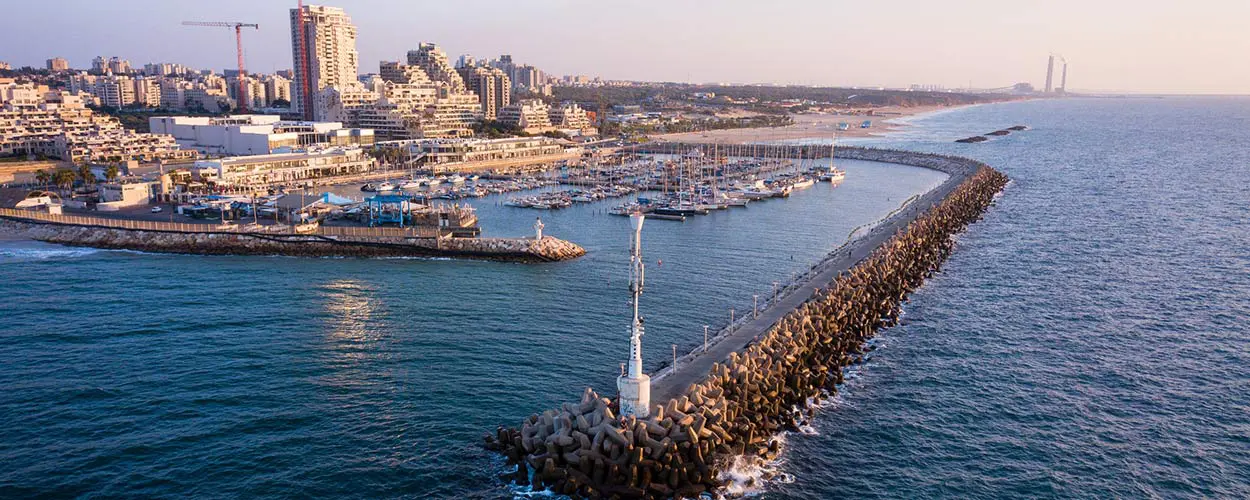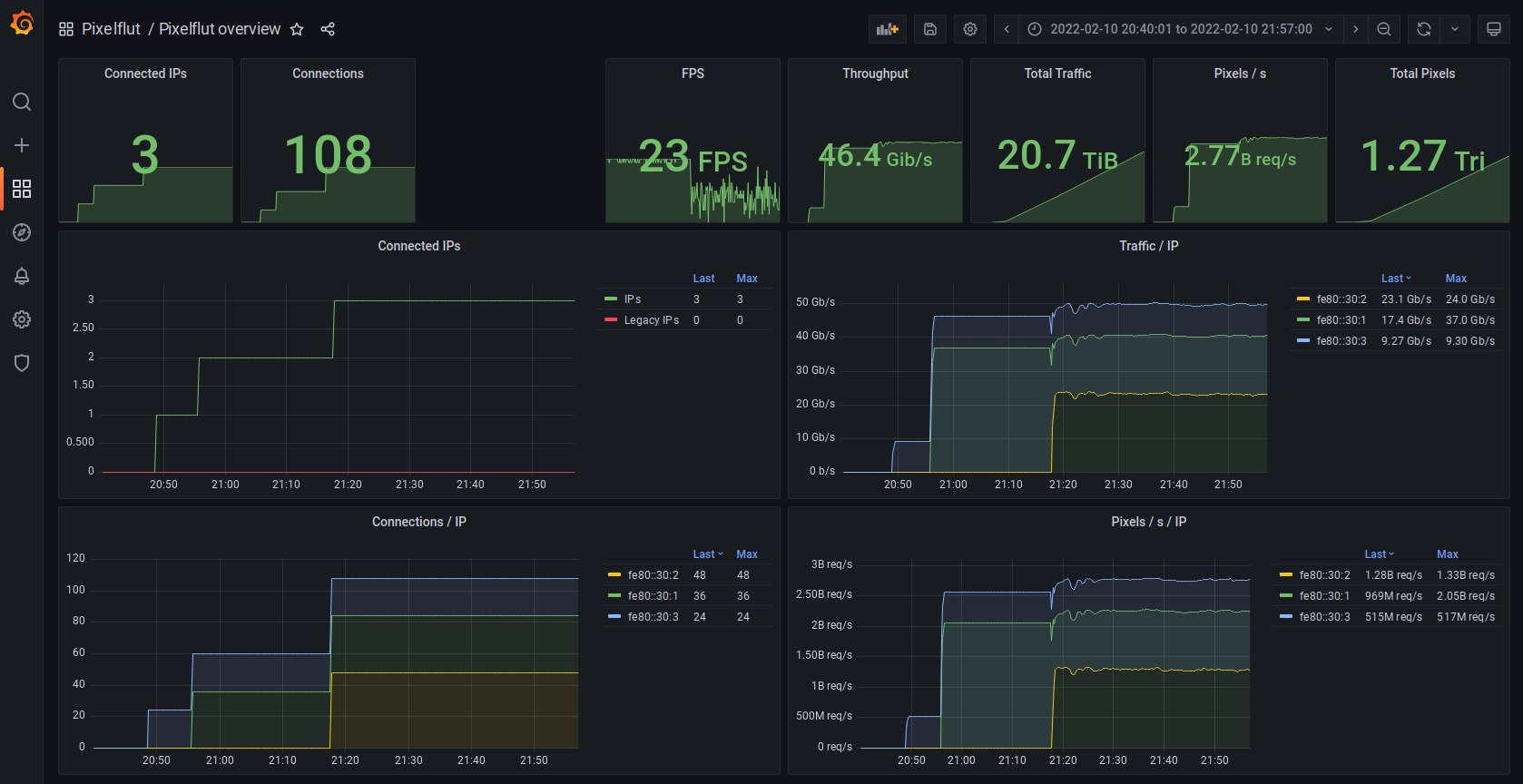breakwater is a very fast Pixelflut server written in Rust. It is heavily inspired by Shoreline.
It claims to be the fastest Pixelflut server in existence - at least at the time of writing 02/2022.

- Accepts Pixelflut commands
- Can provide a VNC server so that everybody can watch
- As an alternative it can stream to a RTMP sink, so that you can e.g. directly live-stream into Twitch or YouTube
- Exposes Prometheus metrics
- IPv6 and legacy IP support
Commands must be sent newline-separated, for more details see Pixelflut
HELP: Prints a help text with the available commands.PX x y rrggbb: PX x y rrggbb: Color the pixel (x,y) with the given hexadecimal color rrggbb, e.g.PX 10 10 ff0000PX x y rrggbbaa: Color the pixel (x,y) with the given hexadecimal color rrggbb (alpha channel is ignored for now), e.g.PX 10 10 ff0000ffPX x y gg: Color the pixel (x,y) with the hexadecimal color gggggg. Basically this is the same as the other commands, but is a more efficient way of filling white, black or gray areas, e.g.PX 10 10 00to paint blackPX x y: Get the color value of the pixel (x,y), e.g.PX 10 10SIZE: Get the size of the drawing surface, e.g.SIZE 1920 1080OFFSET x y: Apply offset (x,y) to all further pixel draws on this connection. This can e.g. be used to pre-calculate an image/animation and simply use the OFFSET command to move it around the screen without the need to re-calculate it, e.g.OFFSET 100 100
The easiest way is to continue with the provided Ready to use Docker setup below.
If you prefer the manual way (the best performance) you need to have Rust installed.
You may need to install some additional packages with sudo apt install pkg-config libvncserver-dev
Then you can directly run the server with
cargo run --releaseThe default settings should provide you with a ready-to-use server.
| Port | Description |
|---|---|
| 1234 | Pixelflut server |
| 5900 | VNC server |
| 9100 | Prometheus metrics exporter |
The get a list of options try
cargo run --release -- --helpOutput
cargo run --release -- --help
Finished release [optimized] target(s) in 0.04s
Running `target/release/breakwater --help`
Usage: breakwater [OPTIONS]
Options:
-l, --listen-address <LISTEN_ADDRESS>
Listen address to bind to. The default value will listen on all interfaces for IPv4 and IPv6 packets [default: [::]:1234]
--width <WIDTH>
Width of the drawing surface [default: 1280]
--height <HEIGHT>
Height of the drawing surface [default: 720]
-f, --fps <FPS>
Frames per second the server should aim for [default: 30]
-t, --text <TEXT>
Text to display on the screen. The text will be followed by "on <listen_address>" [default: "Pixelflut server (breakwater)"]
--font <FONT>
The font used to render the text on the screen. Should be a ttf file. If you use the default value a copy that ships with breakwater will be used - no need to download and provide the font [default: Arial.ttf]
-p, --prometheus-listen-address <PROMETHEUS_LISTEN_ADDRESS>
Listen address the prometheus exporter should listen on [default: [::]:9100]
--statistics-save-file <STATISTICS_SAVE_FILE>
Save file where statistics are periodically saved. The save file will be read during startup and statistics are restored. To reset the statistics simply remove the file [default: statistics.json]
--statistics-save-interval-s <STATISTICS_SAVE_INTERVAL_S>
Interval (in seconds) in which the statistics save file should be updated [default: 10]
--disable-statistics-save-file
Disable periodical saving of statistics into save file
--rtmp-address <RTMP_ADDRESS>
Enable rtmp streaming to configured address, e.g. `rtmp://127.0.0.1:1935/live/test`
--video-save-folder <VIDEO_SAVE_FOLDER>
Enable dump of video stream into file. File location will be `<VIDEO_SAVE_FOLDER>/pixelflut_dump_{timestamp}.mp4
-v, --vnc-port <VNC_PORT>
Port of the VNC server [default: 5900]
-h, --help
Print help
-V, --version
Print versionYou can also build the binary with cargo build --release. The binary will be placed at target/release/breakwater.
Breakwater also has some compile-time features for performance reasons. You can get the list of available features by looking at the Cargo.toml. As of writing the following features are supported
vnc(enabled by default): Starts a VNC server, where users can connect to. Needslibvncserver-devto be installed. Please note that the VNC server offers basically no latency, but consumes quite some CPU.alpha(disabled by default): Respect alpha values duringPXcommands. Disabled by default as this can cause performance degradation.
To e.g. turn the VNS server off, build with
cargo run --release --no-default-features # --features alpha,vnc to explicitly enableFabian Wunsch has introduced initial support for SIMD when parsing the hexadecimal color values in #5. Thanks! We might be able to extend the support, parsing the decimal coordinates or blending colors using alpha using SIMD would be awesome as well. PRs welcome!
As portable_simd is a unstable feature, we configured this project to use nightly Rust in rust-toolchain.toml. Once the feature is stable we can switch back to stable Rust.
If the SIMD or nightly part causes any problems on your setup please reach out by creating an Issue!
This command will start the Pixelflut server in a docker container
docker run --rm --init -t -p 1234:1234 -p 5900:5900 -p 9100:9100 sbernauer/breakwater # --helpIf you want to permanently save statistics (to keep them between restarts) you can use the following command:
mkdir -p pixelflut && docker run --rm -u 1000:1000 --init -t -p 1234:1234 -p 5900:5900 -p 9100:9100 -v "$(pwd)/pixelflut:/pixelflut" sbernauer/breakwater --statistics-save-file /pixelflut/statistics.jsonThe ready to use Docker compose setup contains the Pixelflut server, a prometheus server and a Grafana for monitoring. Use the following command to start the whole setup
docker-compose upYou should now have access to the following services
| Port | Description |
|---|---|
| 1234 | Pixelflut server |
| 5900 | VNC server |
| 9100 | Prometheus metrics exporter |
| 9090 | Prometheus server |
| 80 | Grafana |
If you visit the Grafana server (user=admin, password=admin) you will have access to dashboards like the dashboard below.

My Laptop has a Intel(R) Core(TM) i7-8850H CPU @ 2.60GHz (6 Cores/12 Threads) and 2 DDR4 RAM modules with 16 GB each and 2667 MT/s.
The Pixelflut-server and Pixelflut-client Sturmflut both run on my Laptop using 24 connections.
These are the results of different Pixelflut servers:
| Server | Language | Traffic during first 30s | When thermal throttling |
|---|---|---|---|
| Pixelnuke | C | 1.1 Gbit/s | 1 Gbit/s |
| Pixelwar | Java | 2.1 Gbit/s | 1.6 Gbit/s |
| pixelpwnr-server | Rust | 6.3 Gbit/s | 4.6 Gbit/s |
| Shoreline | C | 15 Gbit/s | 12 Gbit/s |
| Breakwater | Rust | 30 Gbit/s | 22 Gbit/s |
The server has two Intel(R) Xeon(R) CPU E5-2660 v2 @ 2.20GHz processors with 10 cores / 20 threads each.
Another server was used as a Pixelflut-client Sturmflut.
The servers were connected with two 40G and one 10G links, through which traffic was generated.
| Server | Language | Sustainable traffic |
|---|---|---|
| Shoreline | C | 34 Gbit/s |
| Breakwater | Rust | 52 Gbit/s |